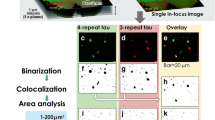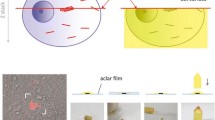Abstract
Silver staining profiles of Pick bodies (PBs) and their relation to tau-like immunoreactivity were examined on hippocampal sections and compared with those of neurofibrillary tangles of Alzheimer type (NFTs). Pairs of mirror sections were double-fluorolabeled with an anti-paired helical filament tau (AT8) antibody and thiazin red (TR), a fluorochrome that identifies fibrillary structures such as NFTs. One of the paired sections was subsequently stained using the Gallyas method (GAL), and the other using the Campbell-Switzer method (CS). By comparison of the same microscopic field on fluorolabeled sections and on both silver-stained paired sections, four different profiles of each structure could be distinguished: AT8 immunoreactivity, affinity to TR, argyrophilia with GAL or CS staining. PBs, containing mainly three-repeat (3R) tau, were positive for CS but not for GAL and its affinity to TR was, at most, weak. This selective affinity of PBs to CS is in sharp contrast with tau-positive structures of corticobasal degeneration/progressive supranuclear palsy, which are positive for GAL but not for CS, as we reported previously. This contrast is explainable if the argyrophilia with CS is related to deposits containing 3R tau, while that with GAL is linked to those containing four-repeat (4R) tau. Indeed, NFTs, containing both 3R and 4R tau, are positive for both CS and GAL, as expected. Taken together, differences in molecular composition of tau protein in these deposits are linked to their argyrophilic properties that are dependent on the staining method. Although explanations for these empirical differences are not yet available, awareness of this clear distinction is potentially of diagnostic and pathological relevance.




Similar content being viewed by others
References
Bodian D (1936) A new method for staining nerve fibers and nerve endings in mounted paraffin sections. Anat Res 65:89
Bolle L, Maurer B, Janzer RC (1992) A modified Hortega-Globus stain is superior to Bielschowsky and Bodian stains for demonstrating neuritic plaques. Biotech Histochem 67:82–87
Braak E, Braak H (1999) Silver staining method for demonstrating Lewy bodies in Parkinson’s disease and argyrophilic oligodendrocytes in multiple system atrophy. J Neurosci Methods 87:111–115
Braak H, Braak E, Ohm TG, Bohl J (1988) Silver impregnation of Alzheimer’s neurofibrillary changes counterstained for basophilic material and lipofuscin pigment. Stain Technol 63:197–200
Buée-Scherrer V, Hof PR, Buée L, Leveugle B, Vermersch P, Perl DP, Olanow CW, Delacourte A (1996) Hyperphosphorylated tau proteins differentiate corticobasal degeneration and Pick’s disease. Acta Neuropathol 91:351–359
Bussière T, Hof PR, Mailliot C, Brown CD, Caillet-Boudin M-L, Perl DP, Buée L, Delacourte A (1999) Phosphorylated serine422 on tau proteins is a pathological epitope found in several diseases with neurofibrillary degeneration. Acta Neuropathol 97:221–230
Campbell SK, Switzer RC, Martin TL (1987) Alzheimer’s plaques and tangles: a controlled and enhanced silver staining method. Soc Neurosci Abstr 13:67
Connolly AAP, Anderton BA, Esiri MM (1987) A comparative study of a silver stain and monoclonal antibody reactions on Alzheimer’s neurofibrillary tangles. J Neurol Neurosurg Psychiatry 50:1221–1224
Cross RB (1982) Demonstration of neurofibrillary tangles in paraffin sections: a quick and simple method using a modification of Palmgren’s method. Med Lab Sci 39:67–69
De Silva R, Lashley T, Gibb G, Hanger D, Hope A, Reid A, Bandopadhyay R, Utton M, Strand C, Jowett T, Khan N, Anderton B, Wood N, Holton J, Revesz T, Lee A (2003) Pathological inclusion bodies in tauopathies contain distinct complements of tau with three or four microtubule-binding repeat domains as demonstrated by new specific monoclonal antibodies. Neuropathol Appl Neurobiol 29:288–302
Duyckaerts C, Brion JP, Hauw JJ, Flament-Durand J (1987) Quantitative assessment of the density of neurofibrillary tangles and senile plaques in senile dementia of the Alzheimer type. Comparison of immunocytochemistry with a specific antibody and Bodian’s protargol method. Acta Neuropathol (Berl) 73:167–170
Gallyas F (1971) Silver staining of Alzheimer’s neurofibrillary changes by means of physical development. Acta Morphol Acad Scient Hung 19:1–8
Gambetti P, Autilio-Gambetti L, Papasozomenos SC (1981) Bodian’s silver method stains neurofilament polypeptides. Science 213:1521–1522
Hicks SP (1946) A rapid pyridine silver stain for nervous tissue and reticular fibers. J Lab Clin Med 31:1375–1377
Hirano A, Zimmerman HM (1962) Silver impregnation of nerve cells and fibers in celloidin sections. A simple impregnation technique. Arch Neurol 6:114–122
Iqbal K, Braak E, Braak H, Zaidi T, Grundke-Iqbal I (1991) A silver impregnation method for labeling both Alzheimer paired helical filaments and their polypeptides separated by sodium dodecyl sulfate-polyacrylamide gel electrophoresis. Neurobiol Aging 12:357–361
Kondoh H, Matsushita M, Kosaka K, Miyazaki N (1993) Staining senile plaques using Bodian’s method modified with methenamine. Biotech Histochem 68:113–116
Lamy C, Duyckaerts C, Delaère P, Payan C, Fermanian J, Poulain V, Hauw JJ (1989) Comparison of seven staining methods for senile plaques and neurofibrillary tangles in a prospective series of 15 elderly patients. Neuropathol Appl Neurobiol 15:563–578
Mailliot C, Sergeant N, Bussière T, Caillet-Boudin M-L, Delacourte A, Buée L (1998) Phosphorylation of specific sets of tau isoforms reflects different neurofibrillary degeneration processes. FEBS Lett 433:201–204
Mercken M, Vandermeern M, Lübke U, Six J, Boons J, Van de Voorde A, Martin J-J, Gheuens J (1992) Monoclonal antibodies with selective specificity for Alzheimer Tau are directed against phosphatase-sensitive epitopes. Acta Neuropathol 84:265–272
Mirra SS, Heyman A, McKeel D, Sumi SM, Crain BJ, Brownlee LM, Hughes JP, Belle G van, Berg L (1991) The consortium to establish a registry for Alzheimer’s disease (CERAD). II. Standardization of the neuropathologic assessment of Alzheimer’s disease. Neurology 42:479–486
Reusche E (1991) Silver staining of senile plaques and neurofibrillary tangles in paraffin sections. A simple and effective method. Pathol Res Pract 187:1045–1049
Rosenwald A, Reusche E, Ogomori K, Teichert H-M (1993) Comparison of silver staining and immunohistology for the detection of neurofibrillary tangles and extracellular cerebral amyloid in paraffin sections. Acta Neuropathol 86:182–186
Sakamoto M, Uchihara T, Hayashi M, Nakamura A, Kikuchi E, Mizutani T, Mizusawa H, Hirai S (2002) Heterogeneity of nigral and cortical Lewy bodies differentiated by amplified triple-labeling for alpha-synuclein, ubiquitin, and thiazin red. Exp Neurol 177:88–94
Switzer RC 3rd (1993) Silver staining methods: their role in detecting neurotoxicity. Ann N Y Acad Sci 679:341–348
Tolnay M, Probst A (1999) Tau protein pathology in Alzheimer’s disease and related disorders. Neuropathol Appl Neurobiol 25:171–187
Uchihara T, Kondo H, Ikeda K, Kosaka K (1995) Alzheimer-type pathology in melanin-bleached sections of substantia nigra. J Neurol 252:485–489
Uchihara T, Mizusawa H, Tsuchiya K, Kondo H, Oda T, Ikeda K (1998) Discrepancy between tau immunoreactivity and argyrophilia by the Bodian method in neocortical neurons of corticobasal degeneration. Acta Neuropathol 96:553–557
Uchihara T, Nakamura A, Yamazaki M, Mori O (2001) Evolution from pretangle neurons to neurofibrillary tangles monitored by thiazin red combined with Gallyas method and double immunofluorescence. Acta Neuropathol 101:535–539
Uchihara T, Nakamura A, Yamazaki M, Mori O, Ikeda K, Tsuchiya K (2001) Different conformation of neuronal tau deposits distinguished by double immunofluorescence with AT8 and thiazin red combined with Gallyas method. Acta Neuropathol 102:462–466
Uchihara T, Ikeda K, Tsuchiya K (2003) Pick body disease and Pick syndrome. Neuropathology 23:318–326
Uchihara T, Shibuya K, Nakamura A, Yagishita S (in press) Silver stains distinguish tau-positive structures in corticobasal degeneration/progressive supranuclear palsy and in Alzheimer’s disease: Comparison between Gallyas and Campbell-Switzer methods. Acta Neuropathol
Vallet PG, Guntern R, Hof PR, Golaz J, Delacourte A, Robakis NK, Bouras C (1992) A comparative study of histological and immunohistochemical methods for neurofibrillary tangles and senile plaques in Alzheimer’s disease. Acta Neuropathol 83:170–178
Wilcock GK, Matthews SM, Moss T (1990) Comparison of three silver stains for demonstrating neurofibrillary tangles and neuritic plaques in brain tissue stored for long periods. Acta Neuropathol 79:566–568
Wisniewski HM, Wen GY, Kim KS (1989) Comparison of four staining methods on the detection of neuritic plaques. Acta Neuropathol 78:22–27
Yamaguchi H, Haga C, Hirai S, Nakazato Y, Kosaka K (1990) Distinctive, rapid, and easy labeling of diffuse plaques in the Alzheimer brain by a new methenamine silver stain. Acta Neuropathol 79:569–572
Yamamoto T, Hirano A (1986) A comparative study of modified Bielshowsky, Bodian and Thioflavin S stains on Alzheimer’s neurofibrillary tangles. Neuropathol Appl Neurobiol 12:3–9
Yen SH, Horoupian DS, Terry RD (1983) Immunocytochemical comparison of neurofibrillary tangles in senile dementia of Alzheimer type, progressive supranuclear palsy, and postencephalitic Parkinsonism. Ann Neurol 13:172–175
Acknowledgements
This work was supported in part by grants from the Ministry of Health and Welfare, Japan (Longevity Science H-14–005) and the Ministry of Education, Culture, Sports, Science and Technology (grant in aid for scientific research B15300118) to T.U.
Author information
Authors and Affiliations
Corresponding author
Rights and permissions
About this article
Cite this article
Uchihara, T., Tsuchiya, K., Nakamura, A. et al. Silver staining profiles distinguish Pick bodies from neurofibrillary tangles of Alzheimer type: comparison between Gallyas and Campbell-Switzer methods. Acta Neuropathol 109, 483–489 (2005). https://doi.org/10.1007/s00401-005-0988-6
Received:
Revised:
Accepted:
Published:
Issue Date:
DOI: https://doi.org/10.1007/s00401-005-0988-6




